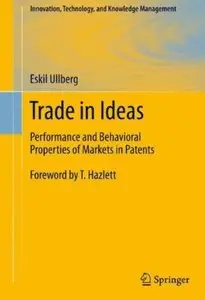Eskil Ullberg - Trade in Ideas: Performance and Behavioral Properties of Markets in Patents
Published: 2011-12-02 | ISBN: 1461412714 | PDF | 225 pages | 3 MB
The economic system is generally understood to operate on the premise of exchange. The most important factor in economic development has always been technology, as a way to expand a limited resource base. Such increase in technology and knowledge is generally accepted by economists, but the mechanisms of exchange through which this happens are much less studied. Generally, a static analysis of product exchange, incorporating new technology, has been undertaken. This book explores the transition of trade in ideas from an exchange largely within firms and nations to an exchange between firms and nations. This process has been going on since the beginning of the patent system, where importing (trading) technology was made policy in 1474, more than 500 years ago. However, during the past 25-30 years, a growth in exchange of technology between specialized firms, cooperating based on patent licensing, has been phenomenal, with annual licensing transactions exceeding a trillion dollars, not counting value of cross-licensing. Such specialized exchange has been seen in history but not at this scale and level of coordination. Using principles of experimental economics, the author investigates the licensing contract and mechanisms of exchange (rules of trade) as this exchange moves towards organized markets with prices. A key issue concerns the effect of introducing demand side bidding, through which the patent system introduces specialization and multiple use of the same technology in different new products, thus expanding the use of technology a firm has to more actors, products, and consumers. The risk and uncertainty in market access for cheaper, better and unique products and services are reduced through new and competitive technology. Questions raised are related to the “optimal” integration of information and rules in dynamic exchange of patents through institutions. The view presented shows how inventors and traders can sell their intellectual property to buyers in a producer market, in this case in licensing contracts on patents, to diversify risk and monetize value based on an experimental economic study where the performance and behavioral properties of these institutions is the object of investigation. More fundamentally the work illustrates the theoretical, design, and patent system policy issues in a transition from personal to impersonal trade in ideas. This book explores the transition of trade in ideas from an exchange largely within firms and nations to an exchange between firms and nations. This process has been going on since the beginning of the patent system, where importing (trading) technology was made policy in 1474, more than 500 years ago. However, during the past 25-30 years, a growth in exchange of technology between specialized firms, cooperating based on patent licensing, has been phenomenal, with annual licensing transactions exceeding a trillion dollars, not counting value of cross-licensing. Such specialized exchange has been seen in history but not at this scale and level of coordination. Using principles of experimental economics, the author investigates the licensing contract and mechanisms of exchange (rules of trade) as this exchange moves towards organized markets with prices. A key issue concerns the effect of introducing demand side bidding, through which the patent system introduces specialization and multiple use of the same technology in different new products, thus expanding the use of technology a firm has to more actors, products, and consumers. The risk and uncertainty in market access for cheaper, better and unique products and services are reduced through new and competitive technology. Questions raised are related to the “optimal” integration of information and rules in dynamic exchange of patents through institutions. The view presented shows how inventors and traders can sell their intellectual property to buyers in a producer market, in this case in licensing contracts on patents, to diversify risk and monetize value based on an experimental economic study where the performance and behavioral properties of these institutions is the object of investigation. More fundamentally the work illustrates the theoretical, design, and patent system policy issues in a transition from personal to impersonal trade in ideas.



